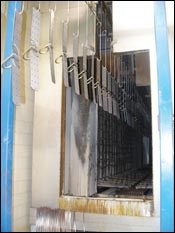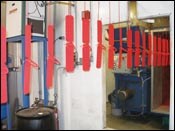A Reputation for Quality
Finisher builds for the future with diversified services
Have you ever heard of a contract finishing shop that does not employ a single sales representative? Probably not, and you might think that such a company would not be around very long.
But, at least in the case of Industrial Electroplating Co. Inc. (IEP; Gastonia, NC), you’d be wrong. Founded in 1971, IEP is not only hanging tough in its original niche of zinc and nickel electroplating, but customer demand has led managers to expand into the powder coating arena and investigate electrocoating as well.
Founder and CEO Walter Prescott has guided IEP since its early days as a two-employee operation housed in a 4,000 ft2 building. From the beginning, Prescott’s goal was to provide top-quality plated parts with quick delivery and thus establish
a reputation for dependability and professionalism.
His success at implementing that strategy is evident: IEP has grown steadily over the years to encompass almost an entire city block, and now operates from several buildings totaling 70,000 ft2 plus a separate 15,000 ft2 warehouse. The company currently has 86 employees and eight automatic electroplating lines.
Even a devastating fire on New Year’s Eve 2000 didn’t slow
growth for long. The blaze destroyed four plating lines and the company’s wastewater treatment system but shut down IEP for only two weeks. Prescott and other employees worked to find alternative plating sources for customers while IEP rebuilt the capabilities that had gone up in smoke. By December 2001, the company was back with all lines operating and a new wastewater system capable of processing 150 gpm.
Adding Powder
IEP’s decision to move into powder coating was not a hasty one, and it was driven by customers, according to Prescott.
“On the positive side, our customers just kept asking for powder coating, to the point where we finally asked them for their expected numbers of parts and current costs for powder coating. A couple of them said, ‘Add powder coating and the business is yours.’
“On the other side, two of our top 10 plating customers took their work offshore,” he continues. “Then we got word that our third-largest electroplating customer was taking its job to China. We’re a small, family-owned company, and losing those customers hurts a small company. So we felt we had to diversify.”
Prescott and IEP managers began by visiting other powder coating job shops that allowed them to tour operations. “Based on that experience, we felt like we could do powder coating,” Prescott recalls.
The push for powder accelerated in 2006 with a supplier search. Eventually, IEP purchased a turnkey powder coating line integrated by Pneu-Mech Systems Mfg. (Statesville, NC). Featuring a Pneu-Mech conveyor and curing oven and two powder booths and application equipment from Nordson Corporation, Industrial Coating Systems (Amherst, OH), the line was installed and operational by mid-December 2006.
Pretreatment Priority
A high-priority item for IEP was to find a cleaning and pretreatment process that fit its needs. “Being involved in electroplating for so long, we knew that if we had good clean parts, we could coat them successfully,” Prescott says. “So cleaning and pretreatment were a big concern.”
Based on visits to other powder coaters, one thing IEP managers knew they wanted to avoid was scale and sludge buildup in pretreatment tanks and on the inside of the pretreatment spray system. “We didn’t want a lot of maintenance and labor to keep the system clean,” recalls IEP industrial chemist Scott Curtis. “When we began visiting powder coating shops, we realized most other shops were using an alkaline cleaner, and they were almost all having issues with sludge buildup in the cleaning stage. We wanted something that would avoid those issues.”
IEP knew MacDermid Enthone (Waterbury, CT) from years of working with the company on the plating side of its operations. But MacDermid supplies more than plating chemistries—the company also develops paint and powder pretreatment chemistries, electrocoat paints and other industrial fluids. “MacDermid came along with a combined cleaner/phosphate chemistry that operated at a pH of 5–5.5,” Curtis says.
“The system has worked very well—we operate it at 120–125°F, and we haven’t had issues with scaling or nozzles plugging. It’s a five-stage washer, and we drain and recharge a stage every quarter.”
Operating at a slightly acidic pH, the chemistry not only minimizes scale and sludge buildup but also helps in parts cleaning. “That pH has enable us to overcome laser burn on sheet metal parts,” Prescott says. “Laser burn and contaminants from welding operations are often an issue in powder coating, but we’ve been very successful in coating welded parts and in being able to remove any weld smut or other contaminants from the parts before coating.”
The five-stage system consists of a cleaner/pretreatment stage, rinse, a second cleaner/pretreatment stage operated at lower concentration than the first, rinse, and a non-chrome sealer. “We use the cleaner/phosphate in Stage 1 at concentration of 2–2.5%,” Curtis explains. “We add a little bit of fluoride to that stage to help remove laser scale from parts. Stage 3 is the same as Stage 1 but at a bit lower concentration. It allows us to get more cleaning plus a bit heavier phosphate buildup.”
An oil skimmer in Stage 1 eliminates potential contamination problems. IEP employees control the system by monitoring concentration and pH twice daily and making adjustments before every shift. Waste treatment is via the company’s existing system, which required no changes to handle the added burden.
Powder Process
After pretreatment, the steel, aluminum and cast iron parts processed on the system travel through a dry-off oven before entering one of the two powder booths. Depending on part geometry, dry-off is accomplished at temperatures ranging from 150–300°F.
With openings of 3 × 5 × 4 ft, the Nordson powder booths are set up for manual operation with a single operator in each booth. IEP currently sprays all colors to waste, but Curtis says the booths can be retrofitted both for automatic operation and to reclaim powder if the need arises.
Pneu-Mech Systems Mfg. LLC. supplied the cure oven and conveyor and integrated the overall system. The oven, with an IR boost followed by natural gas-fired convection heating, cures parts in about 17 min at 400–410°F, depending on the powder material. IEP applies a variety of TGIC powders from different suppliers.
Currently, the company sprays about 15 colors, including several different blacks, several whites, red, blue, Caterpillar yellow and black, and John Deere green, black and yellow. Color changes take anywhere from 5–20 min hour, depending on the colors involved and how long the previous color has been sprayed.
One way IEP speeds changeovers is by maintaining multiple sets of hoses—a set for each color. “Having hoses for each color allows us to clean up the booth, then just change out the hoses instead of trying to blow out hoses and worrying about cross-contamination,” Curtis explains.
The powder line generally runs at a speed of 10 fpm, according to Curtis. Part quality is assured by in-house sampling of coating thickness using an electronic gage. Parts are also sent to an outside lab for adhesion, environmental and other tests. Auxiliary equipment for the system includes a burn-off oven supplied by Steelman Industries Inc. (Kilgore, TX), abrasive blasting equipment and a machine that allows IEP to fabricate its own hooks and racks.
“We use the oven for cleaning racks and hooks, and some customers are now sending parts to us for burn-off,” Prescott says. “We also have abrasive blasting for stripping any parts that may need refinishing, but we haven’t had a lot of rejects. We’ve probably only used the blast system five times over the past year.”
Prescott believes having the ability to produce hooks, racks and other hardware in-house dovetails with IEP’s philosophy of providing quality parts with quick turnaround. “If parts require it, we can come up with unique racking on short notice,” he says. “We really are capable of taking just about any job that comes in, gearing up to finish it and turning it around maybe in one day.”
Moving Forward
After line installation and a trial period for qualification, IEP began coating production parts for its initial heavy truck customers. “The qualification process took three months, and all that time we were learning,” Prescott says. “By the time we were qualified, we were ready, and the first part that went through the line was perfect.”
Since the beginning of 2007, IEP has gained several more customers. The line currently runs two full shifts, with plans for a third and then another powder line.
The other process now on Walter Prescott’s radar is electrocoating. “There seems to be quite a demand for powder coat over E-coat,” he says. “For one of our heavy truck customers, the majority of parts are E-coat, but some have powder over E-coat. For John Deere, really almost all the work we get is a combination of E-coat and powder coat. So we think we can expand that business by adding E-coat capability.”
To add E-coat, IEP will have to move two of its older automatic plating lines. “Right now our plating lines are running on one shift, so we can take those out and run two shifts on the remaining lines to make space for the E-coat line,” Prescott explains.
“We’re hoping to install the E-coat line in late 2009,” he says. “That would make us a full-service finishing company, and would give us a stable base to be here years from now. That’s the goal.”
Read Next
A ‘Clean’ Agenda Offers Unique Presentations in Chicago
The 2024 Parts Cleaning Conference, co-located with the International Manufacturing Technology Show, includes presentations by several speakers who are new to the conference and topics that have not been covered in past editions of this event.
Read MoreEpisode 45: An Interview with Chandler Mancuso, MacDermid Envio Solutions
Chandler Mancuso, technical director with MacDermid Envio discusses updating your wastewater treatment system and implementing materials recycling solutions to increase efficiencies, control costs and reduce environmental impact.
Read MoreEducation Bringing Cleaning to Machining
Debuting new speakers and cleaning technology content during this half-day workshop co-located with IMTS 2024.
Read More


















.jpg;maxWidth=300;quality=90)





